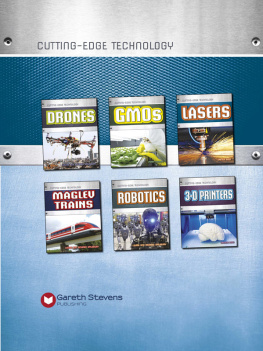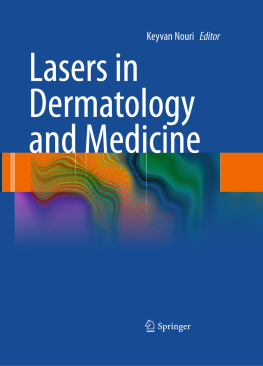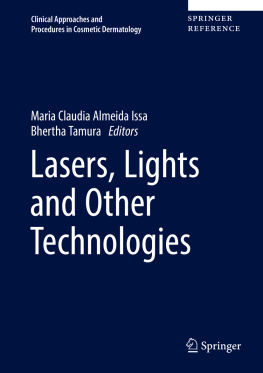Editor
Keyvan Nouri
Leonard M. Miller School of Medicine, University of Miami, Miami, FL, USA
ISBN 978-3-319-76116-9 e-ISBN 978-3-319-76118-3
https://doi.org/10.1007/978-3-319-76118-3
Library of Congress Control Number: 2018950469
Springer International Publishing AG, part of Springer Nature 2018
This work is subject to copyright. All rights are reserved by the Publisher, whether the whole or part of the material is concerned, specifically the rights of translation, reprinting, reuse of illustrations, recitation, broadcasting, reproduction on microfilms or in any other physical way, and transmission or information storage and retrieval, electronic adaptation, computer software, or by similar or dissimilar methodology now known or hereafter developed.
The use of general descriptive names, registered names, trademarks, service marks, etc. in this publication does not imply, even in the absence of a specific statement, that such names are exempt from the relevant protective laws and regulations and therefore free for general use.
The publisher, the authors, and the editors are safe to assume that the advice and information in this book are believed to be true and accurate at the date of publication. Neither the publisher nor the authors or the editors give a warranty, express or implied, with respect to the material contained herein or for any errors or omissions that may have been made. The publisher remains neutral with regard to jurisdictional claims in published maps and institutional affiliations.
This Springer imprint is published by the registered company Springer Nature Switzerland AG
The registered company address is: Gewerbestrasse 11, 6330 Cham, Switzerland
ForewordAnd Forward!
This, Nouris book, is a thorough, recent, practical, and refreshing one that puts laser dermatology into a broader perspective; it is a pleasure to update my brief contribution for this edition. Almost immediately after the first laser was created in 1960, a handful of visionary physicians recognized the potential for surgical applications, starting with the organ systems readily accessible to light. Lasers in laryngology, ophthalmology, and dermatology are so fully adopted now that the standards of care have forever been changed. Now, light is marching inside the body. Laser lithotripsy is widely practiced all over the world. Know-how about lasers and biomedical optics is jumping between medical specialties. Optical coherence tomography, a rapid form of live microscopy invented for retinal imaging, is starting to impact dermatology while making a larger splash for upper GI tract and coronary artery diagnostic imaging. Dermatology was the first to figure out how to target individual pigmented cells with laser pulses, a capability later adopted into ophthalmology for glaucoma treatment. Recently, the various optical nanoparticles developed for laser photo-thermal cancer therapy are being used in dermatology for acne treatment.
How did we get such a wide, almost dazzling, variety of treatment lasers in dermatology? (Because, we need them for different uses in various practice settings; lasers are the most tissue-specific surgical tools in existence.) Do we really need so many? (Well, we need most all of them. Only a few are interchangeable.) Are the mechanistic, clinical, safety, ethical, and practice-related chapters of this book worthy of study? (Yes.) Cant we just learn which buttons to push, in courses provided by the more reputable device manufacturers just after a laser is purchased? (This approach is foolish beyond words, yet such fools exist). Even more foolish are those who purchase a used laser and start using it without any training whatsoever.
A great asset of this book is the breadth of its practical, clinical discussions. There is no substitute for hands-on training, which cannot be obtained even from this practical book. If you use lasers in practice, talk with your colleagues and attend medical laser conferences in which you are free to ask questions to faculty who are not trying to sell something. Many laser companies provide useful information, but are inherently biased. Laser companies are restricted from discussing off-label indications. FDA clearance of a device for a particular indication cannot be taken as assurance that it will work safely and effectively enough to satisfy you and your patients, while lack of FDA clearance for a specific indication cannot be taken as assurance that it will not work safely and effectively. Some of the best uses for dermatological lasers are not FDA-labeled indications, and probably never will be.
It is remarkable what lasers already can do for our patients, yet this field is clearly still in its youth. What comes next? With the advent of fiber laser technology, various industries and telecommunications now have extremely powerful, efficient, wavelength-versatile lasers that operate reliably for decades with little or no maintenance. Those have begun to make their way into dermatology, and may ultimately do better what we do now, plus add wholly new capabilities. Fractional lasers have taught us how amazingly tolerant skin is, to a large volume of micro-injury. Up to 30% of skin can be killed or removed in random, full-thickness wounds that heal rapidly without scarring. The caveat is that every little wound must be less than about 0.4 mm wide. Given that, is it possible to target anything in the skin that can be localized, regardless of its optical or thermal properties? If we knew where various things are in the skin, cant we just aim at them? Yes, we could! Image-guided smart fractional lasers will be used to selectively treat structures and lesions not now addressed with lasersand with that, we will have software-programmable laser targeting. For example, all three cutaneous glandseccrine, sebaceous, and apocrineare reasonable targets, as well as nerves, lymphatics, sensory end organs, mast cells, antigen-presenting cells, and other components of normal skin. Microscopy-driven ablative lasers may even rival conventional microscopic margin-controlled tumor surgery, some day. When laser microscopy and laser tissue ablation are finally married, surgical oncology in general may be impacted. This new era is coming sooner than you think.
I have been fortunate to play a role in launching many aspects of laser dermatology, starting with some fundamental understanding of skin optics, the concept of selective photothermolysis, lasers specifically designed for dermatological use, permanent laser hair removal, scanning confocal laser microscopy, and fractional laser treatments. Each of these arose from trying to understand or solve one clinical problem, but now the panoply of clinical laser applications far exceeds the initial effort. For example, fractional lasers arose as a safer alternative to fully ablative laser skin resurfacing, a safer way to induce skin remodeling. We had no idea that tissue so grossly abnormal as a hypertrophic wound scar could be stimulated to normalize itself this way. Fractional ablative lasers also offer a new way for delivery of topical agents, including very high molecular weight macromolecules, particles, and even cells. The current widespread and diverse use of lasers in dermatology attests not so much to new technology, as to the extreme value of astute clinical observations made by dedicated dermatologists. Nouris text is aimed exactly at achieving that. So please be a gourmet laser chef, not a short-order cook. Contribute to an amazing and evolving part of dermatology.













